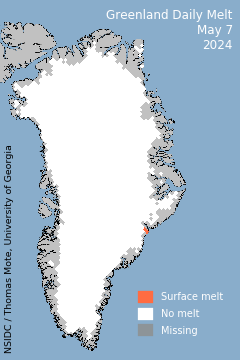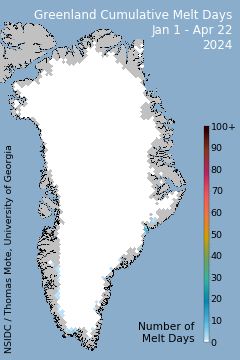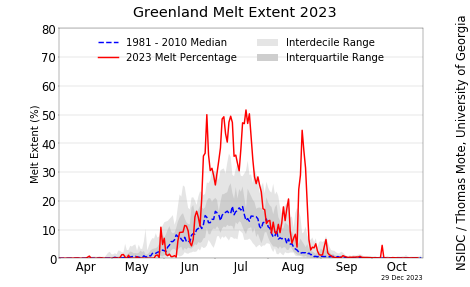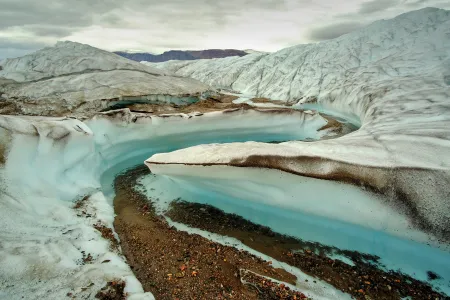
Ice Sheets Today
Greenland Daily Melt Images
About these images: These Greenland melt maps and graph dynamically update on a daily basis, with a one-day lag. On occasion, there is data delay which is usually resolved within a few days. Learn more about how to interpret the data and any known issues.
Featured Antarctic Ice Sheet Melt Images
About these images: These images of the Antarctic Ice Sheet are static and do not update daily, but rather near the timeline of melt analyses posts. Learn more about how to interpret the data and any known issues.
Featured Ice Sheet Analysis
About Ice Sheets Today
Together, the Antarctic and Greenland Ice Sheets contain more than 99 percent of freshwater ice on Earth. If they both completely melted, they would raise sea level by an estimated 67.4 meters (223 feet). Long-term satellite data indicate that through most of the twentieth century, the ice sheets made very little contribution to sea level, and were nearly in balance in annual snowfall gain and ice or meltwater loss. However, the stability of the ice sheets has changed considerably in the twenty-first century.
Ice Sheets Today offers the latest satellite data and scientific analyses on surface melting of the Greenland Ice Sheet in the Northern Hemisphere and Antarctic Ice Sheet in the Southern Hemisphere. Surface melt on each ice sheet results from a combination of daily weather conditions and the amount of solar energy absorbed by its snow and ice. Air temperatures, pressures, and winds drive weather conditions. The quality of snow, its grain size and color, also influence melt. Soot, wildfire ash, and other surface dust darken the snow’s surface and increase solar energy absorption. The extent and duration of this surface melting is an indicator of changing climate and other conditions. It is a major component of the waning of Earth's ice sheets.
The Greenland Ice Sheet melt season typically lasts from April 1 to November 1. The Antarctic Ice Sheet melt season typically lasts from November 1 to April 1.
Ice Sheets Today is produced by NSIDC and funded by NASA as part of the ASINA program.
Other NSIDC Data Analysis Sites
ASINA: Daily images of sea ice and seasonal analyses
Snow Today: Daily images of snow data and seasonal analyses




